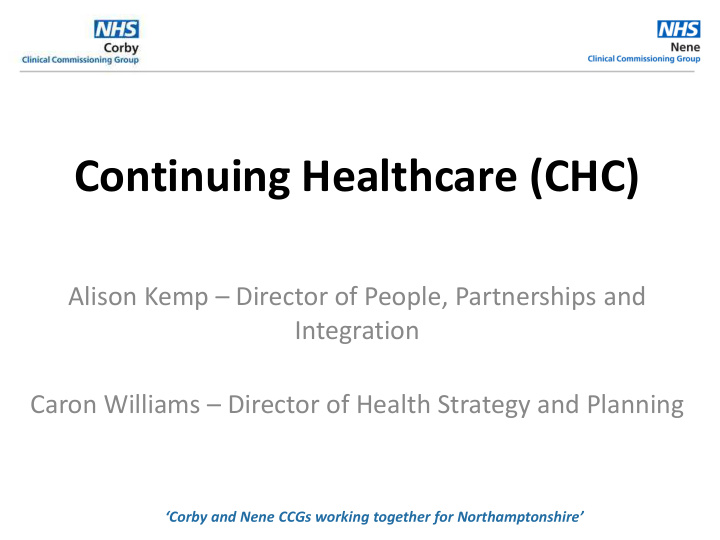



Continuing Healthcare (CHC) Alison Kemp – Director of People, Partnerships and Integration Caron Williams – Director of Health Strategy and Planning ‘Corby and Nene CCGs working together for Northamptonshire’
CHC Transformation • CHC and CCG statutory duties • Current position • LPF Process (Lot 2B) • Outcomes and local requirements • Market Management • Next steps
CCG Statutory Duties NHS Continuing Healthcare means a package of ongoing care that is • arranged and funded solely by the NHS where the individual has been found to have a ‘primary health need’ as set out in the National Guidance (DH revised 2012). Such care is provided to an individual aged 18 or over, to meet needs that • have arisen as a result of disability, accident or illness. The services provided as part of the package should be seen in the wider • context of best practice and service development for each client group. Eligibility for NHS Continuing Healthcare places no limits on the settings in • which the package of support can be offered or on the type of service delivery. CHC is comprised of the following key components: • – Clinical assessment – Brokerage (market management) – Care pathway redesign (CHC is a point of assessment of need and not a care provision service and therefore informs tactical commissioning requirements: frailty, Learning Disabilities, Mental Health, End of Life Care)
Current provision National Picture: Local Picture: Significant focus on eligibility rate reviews and Fluctuating performance in relation to national • • quality including public/media scrutiny requirements notably eligibility assessment National CHC QIPP ask is £220 million savings by Integrated model across CHC provider and CCG • • 2020 considering cost removal not cost transfer supported by external resource (notably to LAs) Risk in relation to the available of ongoing • Changes to the way CHC services are being clinical support to the CCG (workforce) • delivered: Review of options on provision (provider Targeted QIPP programme delivering over – • model) 2017/18 and 2018/19 above plan. This includes Changing market in relation to providers improved assessment, review and the – management of the local market for improved STP impact re pathway integration – value outcomes Changes to the National Framework from • National review of the local system indicates October, mandatory under Gateway instruction: • opportunity to go further in relation to QIPP. Introduction of plans for Personal Health – This was supported by a locally led assessment Budgets process. Eligibility review / package of care reviews – to end requiring improved delivery of PHB model implemented in part but not initial assessments • universal coverage
LPF process In 2016/17 the CCGs undertook a procurement process through the LPF • and CHC provision was included in Lot 2B There was only 1 bidder against the specification who later withdrew • The current local integrated solution is a response to ensuring on-going • provision on an annual NHS contract and MOU arrangement. The LPF does not represent a full market test and the market and local • environment has changed in the period since the procurement was suspended To ensure the delivery of the: CHC clinical assessment services, enhance • the brokerage model, and opportunity to embed CHC in full pathway redesign, a new commissioned solution is required.
Outcomes based model Nationally the traditional CSU model of delivery has been challenged and • other options of best practice are being explored Across England CCGs continue to implement revised models for CHC • delivery through new and integrated solutions in order to manage the service and its demands, both financial and quality Emerging STP models for improved population management with a strong • focus on improving outcomes for individuals with complex needs are developing: place based delivery. CHC necessitates a new model approach - a shift from ‘activity’ to • outcomes; from episodic, fragmented care to a coordinated whole system approach where outcomes are monitored and measured, where cost is controlled and not controlling. The new service model will be required to comply with the CCGs statutory • obligations and the National CHC Framework, provide additionality to the arrangements currently in place and offer improved sustainability.
Key Issues How do we use current levers to deliver improvement: • Current model not delivering best value • National review of model and approach • National requirements to improve process, quality outcomes and costs • Local delivery plan for improvement • HCP programmes for older adults and learning disability
Key components of CHC Care Pathway Clinical Brokerage/Market redesign (tactical Assessment solutions commissioning)
Delivery Model Clinical Assessment Brokerage/Market Care Pathway redesign • Enhanced service • Integrated system specification response required – • Integrated planning alignment with Urgent • Engagement of market supported by Care programme and improved information • Agreed resource HCP plans envelope • Commissioning Board • Section 75 to pool to review and approve budgets and wider resource and reporting
Next Steps • The CCGs have commenced the development of the appropriate outcomes based specification • A resource model and mobilisation plan has been reviewed and will be agreed through the existing transition group • The appropriate market notifications will be issued (August/September) • Internal due diligence will commence noting current contract, national framework and legal requirements (September) • Mobilisation of new service arrangements to be in place from April 2019.
Recommend
More recommend